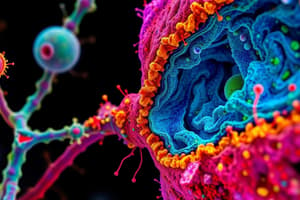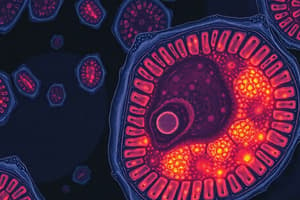Podcast
Questions and Answers
What type of microscopy is used to visualize the small region of a cell in the provided micrograph?
What type of microscopy is used to visualize the small region of a cell in the provided micrograph?
Transmission Electron Microscopy (TEM)
What color indicates the stain for DNA in the example provided?
What color indicates the stain for DNA in the example provided?
Green
Which cellular structure is likely to be identified when using a stain for DNA?
Which cellular structure is likely to be identified when using a stain for DNA?
Nucleus
Why is Transmission Electron Microscopy advantageous for studying cells?
Why is Transmission Electron Microscopy advantageous for studying cells?
What cellular process can be studied using Transmission Electron Microscopy?
What cellular process can be studied using Transmission Electron Microscopy?
Flashcards are hidden until you start studying
Study Notes
Microscopy in Cell Biology
- Microscopy is essential in modern cell biology, aiding in the observation of cellular structures and functions.
- Forms of microscopy include light, fluorescence, and electron microscopy, each offering unique insights into cellular components.
Electron Microscopes
- Invented in the 1930s, electron microscopes utilize beams of electrons for illumination, allowing for higher resolution imaging than light microscopes.
- This technology makes it possible to visualize individual larger molecules that are otherwise undetectable.
Transmission Electron Microscopy (TEM)
- TEM is a type of electron microscopy providing detailed images of thin specimens by transmitting electrons through the sample.
- Micrographs produced by TEM can show intricate details of small regions within a cell, enhancing understanding of cellular architecture.
- DNA can be stained for visualization; specific stains (e.g., green) highlight DNA, demonstrating the technique's effectiveness in molecular observation.
Studying That Suits You
Use AI to generate personalized quizzes and flashcards to suit your learning preferences.




